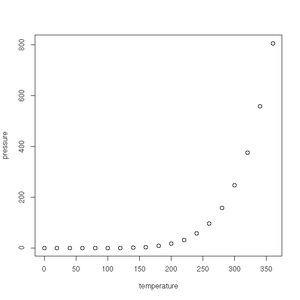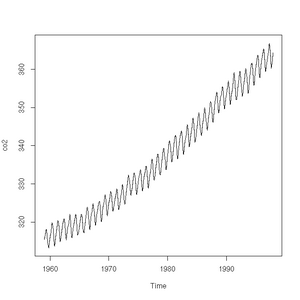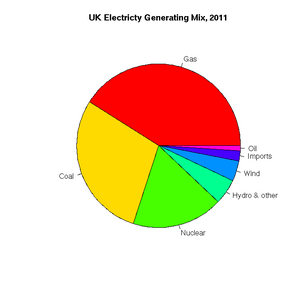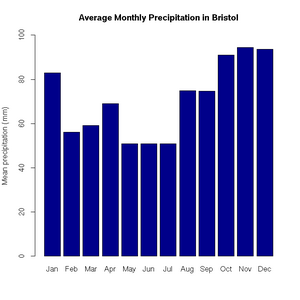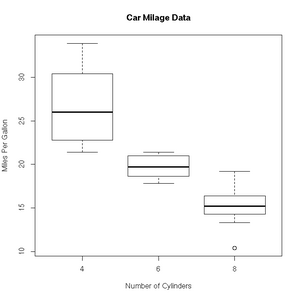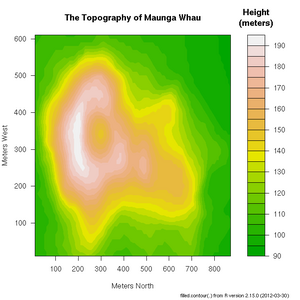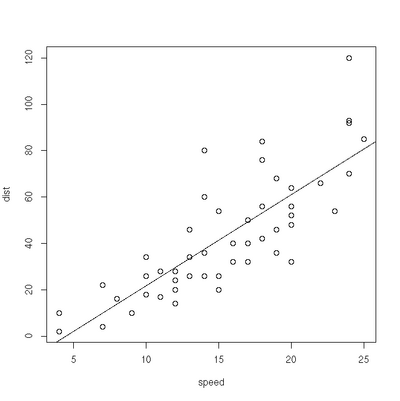Difference between revisions of "R1"
| Line 48: | Line 48: | ||
</source> | </source> | ||
| − | We can access portions of the array using the syntax shown in the square brackets. For example, we can access the first row using the '''[1,]''' notation, and similarly the second column using '''[,2]'''. Since the square is 3x3 magic, the numbers in both slices should sum to 15: | + | Where the '''c''' function combines the arguments given in the parentheses. We can access portions of the array using the syntax shown in the square brackets. For example, we can access the first row using the '''[1,]''' notation, and similarly the second column using '''[,2]'''. Since the square is 3x3 magic, the numbers in both slices should sum to 15: |
<source> | <source> | ||
| Line 66: | Line 66: | ||
[1,] 5 3 | [1,] 5 3 | ||
[2,] 1 8 | [2,] 1 8 | ||
| + | </source> | ||
| + | |||
| + | R also provides '''arrays''', which have more than two dimensions, and '''lists''' to hold heterogeneous collections. | ||
| + | |||
| + | A very commonly used data structure is the '''data frame''', which R uses to store tabular data. Given several vectors of equal length, we can collate them into a data frame: | ||
| + | |||
| + | <source> | ||
| + | > countries <- c("USA", "China", "UK") | ||
| + | > golds <- c(46, 38, 29) | ||
| + | > silvers <- c(29, 27, 17) | ||
| + | > bronzes <- c(29, 23, 19) | ||
| + | > medals.2012 <- data.frame(countries, golds, silvers, bronzes) | ||
| + | > medals.2012 | ||
| + | countries golds silvers bronzes | ||
| + | 1 USA 46 29 29 | ||
| + | 2 China 38 27 23 | ||
| + | 3 UK 29 17 19 | ||
</source> | </source> | ||
Revision as of 13:58, 21 June 2013
Open Source Statistics with R
Introduction
R is a mature, open-source (i.e. free!) statistics package, with an intuitive interface, excellent graphics and a vibrant community constantly adding new methods for the statistical investigation of your data to the library of packages available.
The goal of this tutorial is to introduce you to the R package, and not to be an introductory course in statistics.
Some excellent examples of using R can also be found at: http://msenux.redwoods.edu/math/R
Getting Started
The very simplest thing we can do with R is to perform some arithmetic at the command prompt:
> phi <- (1+sqrt(5))/2
> phi
[1] 1.618034Parentheses are used to modify the usual order of precedence of the operators (/ will typically be evaluated before +). Note the [1] accompanying the returned value. All numbers entered at the console are interpreted as a vector. The '[1]' indicates that the line in question is displaying the vector of values starting at first index. We can use the handy sequence function to create a vector containing more than a single element:
> odds <- seq(from=1, to=67, by=2)
> odds
[1] 1 3 5 7 9 11 13 15 17 19 21 23 25 27 29 31 33 35 37 39 41 43 45 47 49
[26] 51 53 55 57 59 61 63 65 67From the above example, we can see that both the <- and = operators can be used for assignment.
Vectors are commonly used data structures in R:
coords.bris <- c(51.5, 2.6)As are matrices:
> magic <- matrix(data=c(2,7,6,9,5,1,4,3,8),nrow=3,ncol=3)
> magic
[,1] [,2] [,3]
[1,] 2 9 4
[2,] 7 5 3
[3,] 6 1 8Where the c function combines the arguments given in the parentheses. We can access portions of the array using the syntax shown in the square brackets. For example, we can access the first row using the [1,] notation, and similarly the second column using [,2]. Since the square is 3x3 magic, the numbers in both slices should sum to 15:
> sum(magic[1,])
[1] 15
> sum(magic[,2])
[1] 15Single elements and ranges can also accessed:
> magic[2,2]
[1] 5
> magic[2:3,2:3]
[,1] [,2]
[1,] 5 3
[2,] 1 8R also provides arrays, which have more than two dimensions, and lists to hold heterogeneous collections.
A very commonly used data structure is the data frame, which R uses to store tabular data. Given several vectors of equal length, we can collate them into a data frame:
> countries <- c("USA", "China", "UK")
> golds <- c(46, 38, 29)
> silvers <- c(29, 27, 17)
> bronzes <- c(29, 23, 19)
> medals.2012 <- data.frame(countries, golds, silvers, bronzes)
> medals.2012
countries golds silvers bronzes
1 USA 46 29 29
2 China 38 27 23
3 UK 29 17 19Graphics: A taster
R has some very handy built-in data sets. They allow us to, for example, very simply plot the carbon dioxide concentrations as observed from 1959 to 1997 high above Hawaii at the Mauna Loa observatory.
> plot(pressure)> plot(co2)
> class(co2)
[1] "ts"https://www.gov.uk/government/.../5942-uk-energy-in-brief-2012.pdf
> uk.electricty.sources.2011 <- c(41,29,18,5,4,2,1)
> names(uk.electricty.sources.2011) <- ("Gas", "Coal", "Nuclear", "Hydro & other", "Wind", "Imports", "Oil")
> pie(uk.electricty.sources.2011, main="UK Electricty Generating Mix, 2011", col=rainbow(7))http://www.worldweatheronline.com
> bristol.precip <- c(82.9, 56.1, 59.2, 69, 50.8, 50.9, 50.8, 74.8, 74.7, 91.1, 94.5, 93.6)
> names(bristol.precip) <- c("Jan", "Feb", "Mar", "Apr", "May", "Jun", "Jul", "Aug", "Sep", "Oct", "Nov", "Dec")
> barplot(bristol.precip,
+ main="Average Monthly Precipitation in Bristol",
+ ylab="Mean precipitation (mm)",
+ ylim=c(0,100),
+ col=c("darkblue"))> boxplot(mpg~cyl,data=mtcars, main="Car Milage Data",
+ xlab="Number of Cylinders", ylab="Miles Per Gallon")> ?filled.countourData Structures
Packages
Examples of Common Tasks
Linear Regression
> plot(cars)
> res=lm(dist ~ speed, data=cars)
> abline(res)Exercise
- Weighted least squares. The lm function will accept a vector of weights, lm(... weights=...). If given, the function will optimise the line of best fit according a the equation of weighted least squares. Experiment with different linear model fits, given different weighting vectors. Some handy hints for creating a vector of weights:
- w1<-rep(0.1,50) will give you a vector, length 50, where each element has a value of 0.1. W1[1]<-10 will give the first element of the vector a value of 10.
- w2<-seq(from=0.02, to=1.0, by=0.02) provides a vector containing a sequence of values from 0.02 to 1.0 in steps of 0.02 (handily, again 50 in total).
Significance Testing
> boys_2=c(90.2, 91.4, 86.4, 87.6, 86.7, 88.1, 82.2, 83.8, 91, 87.4)
> girls_2=c(83.8, 86.2, 85.1, 88.6, 83, 88.9, 89.7, 81.3, 88.7, 88.4)
> res=var.test(boys_2,girls_2)
> res=t.test(boys_2, girls_2, var.equal=TRUE, paired=FALSE)